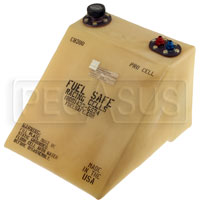Safety fuel cells are required in most forms of racing because they are an important piece of safety equipment. But fuel cells are a part of the car -- and generally buried inside a box in the trunk or under the floor -- so they rarely get the attention they deserve after they are installed. |
What are we talking about?
Safety fuel cells work just like the gas tank on your street car, but they are designed to prevent spilled fuel in the event of a racing incident. (Not to be confused with hydrogen fuel cells, which are used in some electric vehicles to generate electricity. If you're looking for that kind of fuel cell, you're in the right pew but the wrong church.)
Many road racing organizations require fuel cells certified to FIA FT3, FT3.5, or FT5 standards. For that reason, this article will focus on FIA certified cells. Please don't be offended if you get to use something else where you race. Some of this may still apply to you, but not all of it.
Exactly what are fuel cells?
Fuel cells generally consist of three parts: The outer can or enclosure, the bladder, and the foam baffling.
The fuel cell enclosure is typically made of steel or aluminum. It is the cell's first line of defense against damage. You might think of it like the outer shell of your helmet. It's hard and tough, but it has a surprisingly limited role in protecting you. Just as in your helmet, the layer below -- the one you can't see -- is the critical one. In fact, the FIA fuel cell standards do not mention an outer enclosure at all. SCCA (like many others) requires a fully-enveloping enclosure made of 0.036" thick steel or 0.059" aluminum.
The fuel cell bladder is the part that does the really critical work of keeping the fuel inside. In the simplest terms, it is a bag that contains the fuel. The bladder must be strong enough to resist tears and punctures, but it must be flexible enough to deform in a heavy impact without cracking open and leaking. Those two competing requirements have led to the use of very high-tech materials like aramid fibers coated with special elastomers. The resulting bladder is semi-rigid, just hard enough to support its own weight without collapsing.
The fuel cell foam baffling can be thought of as a big sponge inside the fuel cell. If the cell ever did get punctured, and if a fire started, the porous foam baffling would help to prevent the fuel inside the cell from exploding. A happy side benefit is that the baffling also helps to reduce fuel slosh, which would otherwise affect handling.
What are the differences between the FIA ratings?
All three standards lay out the same requirements for materials, construction, and testing. The only difference between them is in the strength of the bladder material. The tests are the same, but the certification is based on the results. FT3 is the lowest level, requiring a minimum of 450 pounds of tensile and puncture strength. FT3.5 is the middle, requiring at least 1000 pounds. The highest level, FT5, requires that the material withstand a full 2000 pounds of tearing and puncturing force. FT5 is required in F1 for obvious reasons. SCCA requires at least FT3 (FT3.5 and FT5 are also acceptable).
One important thing to note about all three standards is Section 2, which states that fuel cells expire 5 years after the date of manufacture.
Wait, my brand-new fuel cell is only good for 5 years?
Manufacturers are given the option to inspect and recertify cells before they expire, but the recertification is limited to 2 years (total maximum lifespan of 7 years).
But my (dad/granddad/great-great-great uncle) had an old rubber cell from Goodyear that lasted forever! Why can't the new ones last that long?
The difference is in the materials that the manufacturers are required to use. The old Goodyear (and Firestone, and Uni-Royal, and Marston, and all the other brands Carroll Smith mentioned in 1974) cells were basically rubber with a layer of fabric reinforcement. They lasted a long time (at least long enough for the car they were in to become obsolete), but they were nowhere near as strong as the elastomer-coated aramid materials that are required by the current FIA standards. The tradeoff is that these stronger materials are only stronger for a limited time. We used to think helmets lasted forever, too.
What causes the cell material to break down?
Many environmental factors contribute to the aging of the bladder. Ozone, UV light, heat, vibration, and even gasoline all work to break down the elastomers over time. Alcohol and water are even more aggressively damaging. If you run an alcohol-bearing gasoline (E15), you must drain the cell after every event. Fuels with high alcohol content (such as E85) actually require different bladder and foam materials than the gasoline cells that we carry.
So can I just install the cell and forget about it for the next 5 years?
No! Your fuel cell may not require the same level of maintenance as your engine, but a little attention will help to make sure that it makes it to the 5 year mark (and maybe even gets a clean bill of health for another 2 years).
Installation: When you get your new cell, inspect the inside of the enclosure for any debris or rough edges that could damage the cell. Smooth any rough edges and clean the inside of the container to minimize the possibility of damage to the bladder. Be sure the bladder and container are completely dry before assembling. Many builders recommend the use of a protective tape (such as our Leading Edge Tape) along the edges and bottom surface of the bladder to protect against chafing. Finally, read (and save) the manufacturer's instructions! Somewhere in that stack of papers that came with the cell is a certificate stating that your new cell meets or exceeds the applicable FIA standard. Bring that certificate with you to the car's first tech inspection. Otherwise, you will be (best-case scenario) dismantling the container to show them the FIA hologram on the bladder, or (worst-case scenario) going home early. It would also be smart to bring that certificate along to each annual tech inspection, and to any out-of-division races. We can't re-issue the certificate if it gets lost or tossed, so please look after it.
Maintenance: Drain the cell completely before off-season storage. If you run an alcohol-bearing fuel, drain the cell immediately after every event. Gasoline exposure affects the bladder, but alcohol attacks the foam baffling. Even with pure hydrocarbon gasoline, you should replace the foam baffling periodically. Annual replacement is overkill with racing gas or AvGas. Every two years is usually sufficient with pure petroleum fuel. Still, prevention is better than losing half a dozen races while all those clogging schnibbles of old broken-down foam try to work their way through your fuel system.
Inspection: While you're busy replacing the foam at the end of the year, take a good look at the bladder. Watch for wear from rubbing against the container (apply Leading Edge Tape as needed). Look for signs of delamination (the elastomer coating separating from the aramid fabric) and cracking in the elastomer coating. Cracks sometimes (but not always) show up as dark areas where fuel and other contaminants have soaked into the inner fabric. Cracks most often (but not always) appear along the folded edges and around the base of molded necks or spouts. Cracks cannot be repaired in the field, and they will not heal on their own. A cracked bladder must be replaced. Fortunately, you're inspecting it right after the last event of the season, and not the weekend before the season-opener... right? So you have plenty of time to order a new cell... right??
Umm... it looks good to me! Never mind that puddle of gas on the floor, I have a race next week.
Yeah, you might want to get a second opinion. Ask someone who cares more about your skin than about your wallet. Here I'm thinking your mom, your spouse, your BFF, your boss, or a total stranger. Your local tech inspector is likely to have a strong opinion, too.


